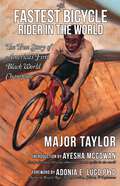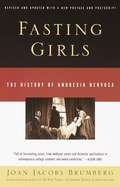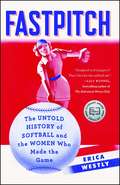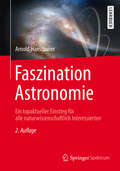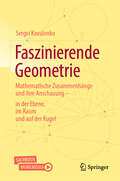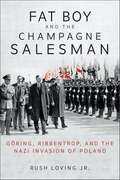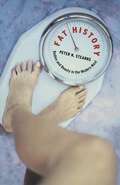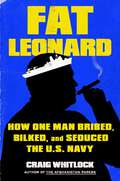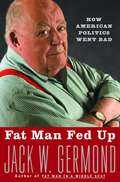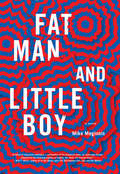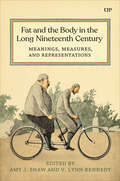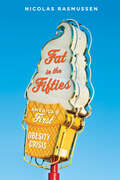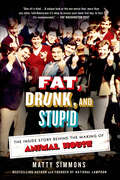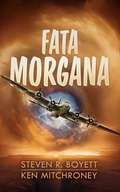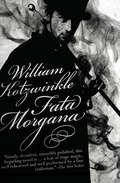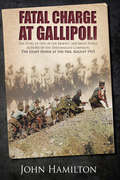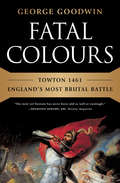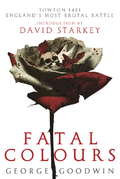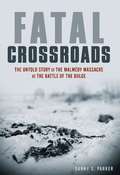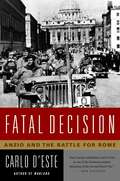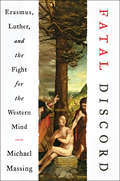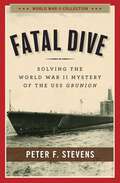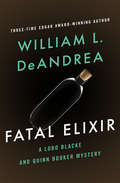- Table View
- List View
Fastest Bicycle Rider in the World, The: The True Story of America’s First Black World Champion
by Major TaylorBorn in 1878, bicycle racer Marshall "Major" Taylor became the first Black sports star to become a global celebrity when he won the world cycling championship in 1899. Throughout his bike-racing career, he won awards and set records on and off the track. But in his native United States, he faced racist discrimination and violence at every turn, causing him to spend most of his time in Europe where fans saw his value. After he retired from racing, Taylor wrote and published his autobiography and traveled the world promoting it. Written in the 1920s, his story feels fresh, contemporary, and readable. His life was too short, but his legacy lives on in the many organizations and clubs that bear his name, and the generations of new cyclists who look up to him. His intelligence, good humor, and global perspective shine through on every page in this candid account of a remarkable life. This new edition features an introduction by bicycle advocate Adonia Lugo, author of Bicycle / Race, as well as a foreward by Ayesha McGowan, the first Black US woman to be a member of a professional road cycling team.
Fasti
by OvidWritten after he had been banished to the Black Sea city of Tomis by Emperor Augustus, the Fasti is Ovid's last major poetic work. Both a calendar of daily rituals and a witty sequence of stories recounted in a variety of styles, it weaves together tales of gods and citizens together to explore Rome's history, religious beliefs and traditions. It may also be read as a subtle but powerful political manifesto which derides Augustus' attempts to control his subjects by imposing his own mythology upon them: after celebrating the emperor as a Jupiter-on-earth, for example, Ovid deliberately juxtaposes a story showing the king of the gods as a savage rapist. Endlessly playful, this is also a work of integrity and courage, and a superb climax to the life of one of Rome's greatest writers.
Fasting Girls: The History of Anorexia Nervosa
by Joan Jacobs BrumbergThis book explores eating disorders, providing both a social history of Anorexia and scientific case studies
Fastpitch: The Untold History of Softball and the Women Who Made the Game
by Erica WestlyIf you think softball is just a "women's version" of the great American pastime of baseball--well, think again.Fastpitch softball is one of the most widely played sports in the world, with tens of millions of active participants in various age groups. But the origins of this beloved sport and the charismatic athletes who helped it achieve prominence in the mid-twentieth century have been largely forgotten, until now. Fastpitch brings to life the eclectic mix of characters that make up softball's vibrant 129-year history. From its humble beginnings in 1887, when it was invented in a Chicago boat club and played with a broomstick, to the rise in the 1940s and 1950s of professional-caliber company-sponsored teams that toured the country in style, softball's history is as diverse as it is fascinating. Though it's thought of today as a woman's sport, fastpitch softball's early years featured several male stars, such as the vaudeville-esque Eddie Feigner, whose signature move was striking out batters while blindfolded. But because softball was one of the only team sports that women were allowed to play competitively, it took on added importance for female athletes. Top fastpitch teams of the 1940s, '50s, and '60s, such as the New Orleans Jax Maids and Connecticut's Raybestos Brakettes, gave women access to employment and travel opportunities that would have been unavailable to them otherwise. At a time when female athletes had almost no prospects, softball offered them a chance to flourish. Women put off marriage and moved across the country just for a shot at joining a strong team. Told from the perspective of such influential players as Bertha Ragan Tickey, who set strikeout records and taught Lana Turner to pitch, and Joan Joyce, who struck out baseball legend Ted Williams and helped found a professional softball league with Billie Jean King, Fastpitch chronicles softball's rich history and its uncertain future (as evidenced by its controversial elimination from the 2012 Olympics and the mounting efforts to have it reinstated). A celebration of this unique American sport and the role it plays in our culture today, Fastpitch is as entertaining as it is inspiring.
Faszination Astronomie
by Arnold Hanslmeier"Astronomie ist eine Wissenschaft die an die Grenzen geht. Man hat es mit unvorstellbar riesigen Raum- und Zeitdimensionen zu tun, unvorstellbaren heisen und auch kalten Objekten, und selbst in unserem mittlerweile auch durch Satellitenmissionen gut erforschtem Sonnensystem gibt es laufend neue Entdeckungen." (Aus dem Vorwort) In diesem Buch, das aus einer an der Universität Graz gehaltenen Vorlesung für Studierende aller Fakultäten entstanden ist, vermittelt Prof. Arnold Hanslmeier astronomische Kenntnisse, ohne dabei zuviel auf Physik und Mathematik einzugehen. Etwas tiefergehende Formeln und Textstellen sind vom Rest des Textes getrennt und können, ohne den Zusammenhang zu verlieren, übersprungen werden. Das Buch beginnt mit der Beschreibung des Ursprungs des Universums und reicht bis hin zu dunkler Materie, schwarzen Löchern und der Entstehung des Sonnensystems. Mit Hilfe vieler farbiger Bilder erläutert der Autor die Zusammenhänge anschaulich und allgemein verständlich. Am Ende des Buches geht es schließlich um die spannende Frage: Sind wir alleine im Universum? Das Buch wendet sich nicht nur an Studierende sondern auch an interessierte Laien sowie an alle die sich mit modernen Erkenntnissen der Naturwissenschaft beschäftigen. "Physik, insbesondere Astrophysik kann extrem spannend sein, ich hoffe, meine Leserinnen und Leser gewinnen durch die Lektüre dieses Buches diesen Eindruck!" A. Hanslmeier
Faszinierende Geometrie: Mathematische Zusammenhänge und ihre Anschauung – in der Ebene, im Raum und auf der Kugel
by Sergei KovalenkoIn diesem Buch findest du eine detaillierte und zugleich sehr anschauliche Darstellung ausgewählter Inhalte aus der elementaren Geometrie, untermauert mit historischem Kontext und geschichtlichen Erzählungen. Neben den klassischen Sätzen und Ergebnissen der ebenen und räumlichen Geometrie und Trigonometrie werden auch speziellere Themen behandelt – etwa die sphärische Geometrie oder die theoretischen Grundlagen der Konstruktion geometrischer Objekte mit Hilfe von Lineal und Zirkel. Das Buch richtet sich an alle, die sich für Geometrie, ihre theoretischen Aspekte und deren Zusammenhänge sowie für ihre vielfältigen Anwendungen interessieren; es setzt nur mathematische Grundkenntnisse wie Term- und Äquivalenzumformungen voraus. Insbesondere Lehramtsstudierenden sowie Lehrerinnen und Lehrern kann es neue kreative Impulse zur Weitergabe an jüngere Generationen liefern.
Fat Boy and the Champagne Salesman: Göring, Ribbentrop, and the Nazi Invasion of Poland
by Rush Loving Jr.Fat Boy and the Champagne Salesman offers a compelling behind-the-scenes exploration of the road to World War II and the invasion of Poland by the Hitler's Third Reich. Focusing on the personal power plays within Hitler's inner circle, author Rush Loving details the struggle for Hitler's approval, long before the battle for Poland had begun. The rivalry was between "Fat Boy," the moniker given to Hermann Göring by his fellow Nazi generals, and "the Champagne Salesman," Joachim von Ribbentrop, nicknamed for his previous career, and it was at the heart of Germany's plans for the expansion of the Reich into Poland. Göring, founder of the Lüftwaffe and the man who oversaw the armaments industry, was convinced that any invasion of Poland would lead to war with England and France, who were committed to its defense. Von Ribbentrop, Hitler's foreign minister, argued that the Allies would stand down and continue their policy of appeasement. Only one would be proved correct. An engrossing and dramatic tale, Fat Boy and the Champagne Salesman shows Göring and Ribbentrop playing a tug-of-war with Hitler's will. Loving's vivid narrative of the struggle between the two advisers lends a new understanding of the events leading to the opening days of World War II.
Fat History: Bodies and Beauty in the Modern West
by Peter N. StearnsThe modern struggle against fat cuts deeply and pervasively into American culture. Dieting, weight consciousness, and widespread hostility toward obesity form one of the fundamental themes of modern life. Fat History explores the meaning of fat in contemporary Western society and illustrates how progressive changes, such as growth in consumer culture, increasing equality for women, and the refocusing of women's sexual and maternal roles have influenced today's obsession with fat. Brought up-to-date with a new preface and filled with narrative anecdotes, Fat History explores fat's transformation from a symbol of health and well-being to a sign of moral, psychological, and physical disorder.
Fat Leonard: How One Man Bribed, Bilked, and Seduced the U.S. Navy
by Craig Whitlock#1 New York Times bestselling author Craig Whitlock&’s masterful account of one of the biggest public corruption scandals in American history—exposing how a charismatic Malaysian defense contractor bribed scores of high-ranking military officers, defrauded the US Navy of tens of millions of dollars, and jeopardized our nation&’s security.All the admirals in the US Navy knew Leonard Glenn Francis—either personally or by his legendary reputation. He was the larger-than-life defense contractor who greeted them on the pier whenever they visited ports in Asia, ready to show them a good time after weeks at sea while his company resupplied their ships and submarines. He was famed throughout the fleet for the gluttonous parties he hosted for officers: $1,000-per-person dinners at Asia&’s swankiest restaurants, featuring unlimited Dom Pérignon, Cuban cigars, and sexy young women. On the surface, with his flawless American accent, he seemed like a true friend of the Navy. What the brass didn&’t realize, until far too late, was that Francis had seduced them by exploiting their entitlement and hubris. While he was bribing them with gifts, lavish meals, and booze-fueled orgies, he was making himself obscenely wealthy by bilking American taxpayers. Worse, he was stealing military secrets from under the admirals&’ noses and compromising national security. Based on reams of confidential documents—including the blackmail files that Francis kept on Navy officers—Fat Leonard is the full, unvarnished story of a world-class con man and a captivating testament to the corrosive influence of greed within the ranks of the American military.
Fat Man Fed Up: How American Politics Went Bad
by Jack W. GermondFor more than forty years, Jack Germond has been covering politics for Gannett newspapers, the Washington Star, and the Baltimore Sun, and talking politics on the Today show, The McLaughlin Group, and Inside Washington. Now, in Fat Man Fed Up, Germond confronts the most critical issues raised by our election process and offers a scathing but wry polemic about what's wrong with American politics.
Fat Man and Little Boy
by Mike MeginnisTwo bombs over Japan. Two shells. One called Little Boy, one called Fat Man. Three days apart. The one implicit in the other. Brothers.Named one of Flavorwire's best independent books of 2014, and winner of the 2013 Horatio Nelson Fiction Prize.<P><P>In this striking debut novel, the atomic bombs dropped on Japan are personified as Fat Man and Little Boy. This small measure of humanity is a cruelty the bombs must suffer. Given life from death, the brothers' journey is one of surreal and unsettling discovery, transforming these symbols of mass destruction into beacons of longing and hope."Impressive. . . The novel straddles a hybrid genre of historical magical realism." - The Japan Times"Meginnis's talent is his ability to make the reader feel empathy for souls who killed so many. . . Many pages in this novel feel like engravings . . . Meginnis has written one of the best, most natural novels about the atomic bombs." - Nick Ripatrazone, The Millions"[An] imaginative debut. . . Meginnis' story is both surprising and incisive." - Publishers WeeklyNamed one of "the year's most impressive debut novelists" by the 2014 Brooklyn Book Festival"An imaginative and surprisingly intimate look at the consequences of our actions and the costs of war." - Library Journal"In his inventive and fabulist debut novel Fat Man and Little Boy Mike Meginnis lends a surprisingly human dimension to the atomic bombs dropped on Japan during World War II." - Largehearted Boy"Throughout Fat Man and Little Boy, Meginnis's language is luminous and disarmingly spare, whether he is invoking a naturalist moment or a fantastical metamorphosis." - Necessary Fiction"Beguiling, strange, and strangely lovely, Fat Man and Little Boy is a deeply sorrowful yet mysteriously empowering debut."-Patrick deWitt, author of The Sisters Brothers"Only someone with the deftness of heart of a writer like Mike Meginnis could redefine the war novel into something like Fat Man and Little Boy, a book which translates our basic world of never-ending terror into a highly nuanced and inventive diorama available absolutely nowhere else."-Blake Butler, author of Scorch Atlas and There is No Year"Mike Meginnis is my favorite kind of writer-extraordinarily inventive, formally curious, profoundly moving-and his Fat Man and Little Boy is a debut of impressive ambition, a reinvention of the historical novel, an existential thriller powered by the booming engines of history, the atom, the human heart." -Matt Bell, author of In the House upon the Dirt between the Lake and the Woods"In Fat Man and Little Boy, Mike Meginnis takes the mother of all atrocities and makes it strange, sizable, turns it so sideways that we're forced to notice, to take heed. This alone is an achievement, but it's the way he does it that dazzles-with gorgeous, careful prose that gives us human failings and a desperate longing for connection so vividly rendered that we have no choice but drink it in, to reckon once again with this disaster in our own time and way."-Amber Sparks, author of The Desert Places and May We Shed These Human Bodies
Fat and the Body in the Long Nineteenth Century: Meanings, Measures, and Representations
by V. Lynn Kennedy Amy J. ShawIn the nineteenth and early twentieth centuries, the body was a key focus of discourse. Fat and the Body in the Long Nineteenth Century animates discussion and analyses of fatness, highlighting how corporeal expectations fit into larger social systems and showing how interpretations have shifted over time. This collection examines a host of primary sources – including literature, art, medical treatises, journalism, political cartoons, soldiers’ letters home, and popular fiction – to identify trends in how fat was perceived and promoted in the English-speaking world over the long nineteenth century. Divided into four thematic sections, the book addresses epistemologies, artistic and literary representations, the turn towards quantification and measurement, and the connections to imperialism and colonialism. It explores the complex debate about the meaning of fat and its signalling of health, beauty, moral strength, and class status. The book shows how contemporary presentations and discussions of fat offer insights into ideals of gender and race and the processes of imperialism and of professionalization in the social sciences and medicine. By tracing how debates shifted over time, the book ultimately reveals that there was no universal interpretation of fat as a positive or negative characteristic throughout the nineteenth century.
Fat in the Fifties: America's First Obesity Crisis
by Nicolas RasmussenA riveting history of the rise and fall of the obesity epidemic during 1950s and 1960s America.Metropolitan Life Insurance Company identified obesity as the leading cause of premature death in the United States in the 1930s, but it wasn't until 1951 that the public health and medical communities finally recognized it as "America's Number One Health Problem." The reason for MetLife's interest? They wanted their policyholders to live longer and continue paying their premiums. Early postwar America responded to the obesity emergency, but by the end of the 1960s, the crisis waned and official rates of true obesity were reduced— despite the fact that Americans were growing no thinner. What mid-century factors and forces established obesity as a politically meaningful and culturally resonant problem in the first place? And why did obesity fade from public—and medical—consciousness only a decade later? Based on archival records of health leaders as well as medical and popular literature, Fat in the Fifties is the first book to reconstruct the prewar origins, emergence, and surprising disappearance of obesity as a major public health problem. Author Nicolas Rasmussen explores the postwar shifts that drew attention to obesity, as well as the varied approaches to its treatment: from thyroid hormones to psychoanalysis and weight loss groups. Rasmussen argues that the US government was driven by the new Cold War and the fear of atomic annihilation to heightened anxieties about national fitness. Informed by the latest psychiatric thinking—which diagnosed obesity as the result of oral fixation, just like alcoholism—health professionals promoted a form of weight loss group therapy modeled on Alcoholics Anonymous. The intervention caught on like wildfire in 1950s suburbia. But the sense of crisis passed quickly, partly due to cultural changes associated with the later 1960s and partly due to scientific research, some of it sponsored by the sugar industry, emphasizing particular dietary fats, rather than calorie intake.Through this riveting history of the rise and fall of the obesity epidemic, readers gain an understanding of how the American public health system—ambitious, strong, and second-to-none at the end of the Second World War—was constrained a decade later to focus mainly on nagging individuals to change their lifestyle choices. Fat in the Fifties is required reading for public health practitioners and researchers, physicians, historians of medicine, and anyone concerned about weight and weight loss.
Fat, Drunk, and Stupid: The Inside Story Behind the Making of Animal House
by Matty SimmonsIn 1976 the creators of National Lampoon, America's most popular humor magazine, decided to make a movie. It would be set on a college campus in the 1960s, loosely based on the experiences of Lampoon writers Chris Miller and Harold Ramis and Lampoon editor Doug Kenney. They named it Animal House, in honor of Miller's fraternity at Dartmouth, where the members had been nicknamed after animals. Miller, Ramis, and Kenney wrote a film treatment that was rejected and ridiculed by Hollywood studios—until at last Universal Pictures agreed to produce the film, with a budget of $3 million.A cast was assembled, made up almost completely of unknowns. Stephen Furst, who played Flounder, had been delivering pizzas. Kevin Bacon was a waiter in Manhattan when he was hired to play Chip. Chevy Chase was considered for the role of Otter, but it wound up going to the lesser-known Tim Matheson. John Belushi, for his unforgettable role as Bluto, made $40,000 (the movie's highest-paid actor). For four weeks in the fall of 1977, the actors and crew invaded the college town of Eugene, Oregon, forming their own sort of fraternity in the process. The hilarious, unforgettable movie they made wound up earning more than $600 million and became one of America's most beloved comedy classics. It launched countless careers and paved the way for today's comedies from directors such as Judd Apatow and Todd Phillips.Bestselling author Matty Simmons was the founder of National Lampoon and the producer of Animal House. In Fat, Drunk, and Stupid, he draws from exclusive interviews with actors including Karen Allen, Kevin Bacon, Peter Riegert, and Mark Metcalf, director John Landis, fellow producer Ivan Reitman, and other key players—as well as behind-the-scenes photos—to tell the movie's outrageous story, from its birth in the New York offices of the National Lampoon to writing a script, assembling the perfect cast, the wild weeks of filming, and, ultimately, to the film's release and megasuccess. This is a hilarious romp through one of the biggest grossing, most memorable, most frequently quoted, and most celebrated comedies of all time.
Fata Morgana
by Steven R. Boyett Macleod Andrews Ken MitchroneyFata Morgana—the epic novel of love and duty at war across the reach of time.At the height of the air war in Europe, Captain Joe Farley and the baseball-loving, wisecracking crew of the B-17 Flying Fortress Fata Morgana are in the middle of a harrowing bombing mission over East Germany when everything goes sideways. The bombs are still falling and flak is still exploding all around the 20-ton bomber as it is knocked like a bathtub duck into another world.Suddenly stranded with the final outcasts of a desolated world, Captain Farley navigates a maze of treachery and wonder—and finds a love seemingly decreed by fate—as his bomber becomes a pawn in a centuries-old conflict between remnants of advanced but decaying civilizations. Caught among these bitter enemies, a vast power that has brought them here for its own purposes, and a terrifying living weapon bent on their destruction, the crew must use every bit of their formidable inventiveness and courage to survive.“With Fata Morgana, Steven Boyett and Ken Mitchroney have created a work that defies categorization, unless that category is “engrossing, brilliant story-telling.” They breathe life into the past and the future, in a book that manages to be both thought-provoking and thrilling. I loved it!” -Jan Burke, New York Times best-selling author of Bones and The Messenger“Gripping adventure stuff: a perfect updating of a classic mode of science fictional storytelling, modernized without losing any of the charm of those old, glorious war novels.”-Cory Doctorow, New York Times best-selling author of Walkaway“Action, adventure, cool speculative events, well-drawn characters, and an ending that sticks the landing: Fata Morgana pushes all my happy buttons.” — John Scalzi, New York Times bestselling author“The twists, turns, and adrenaline never stop flowing in Fata Morgana. You will be transported to another world in more ways than one. Easily one of the hardest hitting science fiction books of 2017!” — Nicholas Sansbury Smith, USA Today bestselling author of Hell Divers“So gripping and real it felt as if it were logged just minutes after landing. Fata Morgana is squarely in the ranks of the most classic and ingenious science fiction—a masterwork of purest cinema, relentlessly charming and inventive to the end.” — Chris Sanders, director of Lilo & Stitch and How to Train Your Dragon“A rip-roaring adventure full of heart, duty, and sacrifice, Fata Morgana is a perfect combination of historical-novel authenticity and space-opera splendor. I couldn’t put it down, and the ending made me cry.” — Brooke Johnson, author of the Chroniker City series“Fata Morgana is genre-bending, epic, and wholly original: an unexpected, fascinating page-turner.” —Lee Kelly, author of A Criminal Magic and City of Savages
Fata Morgana
by William KotzwinkleFrom the award-winning legend of speculative fiction, &“a witty sendup of the detective story&” with &“a richness of invention that doffs a hat to Dickens&” (Chicago Tribune). At a fashionable salon, Parisians line up to have their fortunes told by Ric Lazare&’s amazing machine. The predictions arrive with unerring accuracy, as if the invention were imbued with some sort of wondrous sorcery. The police, however, have a different opinion. They suspect that Lazare is a con man. Accordingly, they&’ve sent one of their own to investigate. Unfortunately, the man they send is Paul Picard. His methods are unconventional. His appetites—for lemon tarts, and for prostitutes—are legendary. And he is no stranger to the dark side of Paris. But Inspector Picard is entirely unprepared for the string of murders that pulls him across the continent. As the killer&’s seductive knot tightens around him, he learns once and for all that there&’s more to the glimmering world of high society than first appears. Winner of the World Fantasy Award for his novel Doctor Rat, William Kotzwinkle reaffirms his reputation as one of the most captivating and original American authors of the last half-century with this &“elegant entertainment&” of magic and mystery in Paris (The Washington Post). &“Gaudy, decadent, smoothly polished, this beguiling novel is . . . a feat of stage magic, well rehearsed and well performed by a fine craftsman.&” —The New Yorker &“Alternately dark and glittering . . . a first-rate vaudeville turn.&” —Chicago Tribune &“Pure magic.&” —Playboy
Fatal Charge at Gallipoli: The Story of One of the Bravest and Most Futile Actions of the Dardanelles Campaign–The Light Horse at The Nek–August 1915
by John HamiltonArmed only with rifles, bayonets and raw courage, the men of the 3rd Light Horse Brigade left the shelter of their rocky trenches to storm The Nek, a narrow stretch of ridge held by the Ottoman Turks. The first wave of attackers were cut down almost as soon as they stood up. Those that followed knew they were going to die. Yet they too charged without question, stumbling over the bodies of their fallen comrades before they also fell.The commander of the 10th Light Horse Regiment attempted to have the third wave cancelled, claiming that 'the whole thing was nothing but bloody murder', but he could not convince the Brigade Major.Using the letters and diaries of those who fought and died in this famously futile action, award-winning journalist and best-selling author, John Hamilton takes the reader on a journey from the rush to recruit in August 1914 when war was declared, through the training camps to the unforgiving terrain of Gallipoli and the unbending Turkish defenders, and finally to that fateful morning and that fatal charge.Part of a trilogy by John Hamilton, this title was first published in 2004 by Pan Macmillan Australia, only being sold in the Australian and New Zealand markets, under the title Goodbye Cobber, God Bless You: The Fatal Charge of the Light Horse, Gallipoli, August 7th, 1915.
Fatal Colours: Towton 1461-England's Most Brutal Battle
by David Starkey George GoodwinThe tumultuous reign of Henry VI and its climax in the carnage of Towton--the bloodiest battle fought on English soil. The battle of Towton in 1461 was unique in its ferocity and brutality, as the armies of two kings of England engaged with murderous weaponry and in appalling conditions to conclude the first War of the Roses. Variously described as the largest, longest, and bloodiest battle on English soil, Towton was fought with little chance of escape and none of surrender. Yet, as if too ghastly to contemplate, the battle itself and the turbulent reign of Henry VI were neglected for centuries. Combining medieval sources and modern scholarship, George Goodwin colorfully re-creates the atmosphere of fifteenth-century England. From the death of the great Henry V and his baby son's inheritance first of England and then of France, Goodwin chronicles the vicious infighting at home in response to the vicissitudes of the Hundred Years War abroad. He vividly describes the pivotal year of 1450 and a decade of breakdown for both king and kingdom, as increasingly embittered factions struggle for a supremacy that could be secured only after the carnage of Towton. Fatal Colours includes a cast of strong and compelling characters: a warrior queen, a ruthless king-making earl, even a papal legate who excommunicates an entire army. And at its center is the first full explanation for the crippling incapacity of the enduringly childlike Henry VI--founder of Eton and King's College, Cambridge. With a substantive and sparkling introduction by David Starkey, Fatal Colours brings to life a vibrant and violent age.
Fatal Colours: Towton, 1461 - England's Most Brutal Battle
by George GoodwinA gripping account of the Wars of the Roses battle of Towton - the most brutal day in English history.'Vivid, humane and superbly researched' David Starkey'The story has never been told so well or so excitingly' Desmond SewardThe Battle of Towton in 1461 was unique in its ferocity and brutality, as the armies of two kings of England engaged with murderous weaponry and in appalling conditions to conclude the first War of the Roses. Variously described as the largest, longest and bloodiest battle on English soil, Towton was fought with little chance of escape and none of surrender. Fatal Colours includes a cast of strong and compelling characters: a warrior queen, a ruthless king-making earl, even a papal legate who excommunicates an entire army.Combining medieval sources and modern scholarship, George Goodwin colourfully recreates the atmosphere of 15th century England and chronicles the vicious in-fighting as the increasingly embittered royal factions struggle for supremacy.
Fatal Colours: Towton, 1461 - England's Most Brutal Battle
by George GoodwinA gripping account of the Wars of the Roses battle of Towton - the most brutal day in English history.'Vivid, humane and superbly researched' David Starkey'The story has never been told so well or so excitingly' Desmond SewardThe Battle of Towton in 1461 was unique in its ferocity and brutality, as the armies of two kings of England engaged with murderous weaponry and in appalling conditions to conclude the first War of the Roses. Variously described as the largest, longest and bloodiest battle on English soil, Towton was fought with little chance of escape and none of surrender. Fatal Colours includes a cast of strong and compelling characters: a warrior queen, a ruthless king-making earl, even a papal legate who excommunicates an entire army.Combining medieval sources and modern scholarship, George Goodwin colourfully recreates the atmosphere of 15th century England and chronicles the vicious in-fighting as the increasingly embittered royal factions struggle for supremacy.
Fatal Crossroads: The Untold Story of the Malmedy Massacre at the Battle of the Bulge
by Danny ParkerOn December 17, 1944, during the Battle of the Bulge, more than eighty unarmed United States soldiers were shot down after having surrendered to an SS unit near the small crossroads town of Malmédy, Belgium. Although more than thirty men lived to tell of the massacre, exactly what took place that day remains mired in controversy. Was it just a "battlefield incident” or rather a deliberate slaughter? Who gave the orders: infamous SS leader Jochen Peiper or someone else? Fatal Crossroads vividly reconstructs the critical events leading up to the atrocity-for the first time in all their revealing detail-as well as the aftermath. Danny S. Parker spent fifteen years researching original sources and interviewing more than one hundred witnesses to uncover the truth behind the Malmédy massacre, and the result is riveting.
Fatal Decision
by Carlo D'EsteFatal Decision is a powerful, dramatic, moving, and ultimately definitive narrative of one of the most desperate campaigns of World War II. In the winter of 1943-44, Anzio, a small Mediterranean resort and port some thirty-five miles south of Rome, played a crucial role in the fortunes of World War II as the target of an amphibious Allied landing. The Allies planned to bypass the strong German defenses along the Gustav Line and at Monte Cassino sixty miles to the southeast, which were holding up the American and British armies and preventing the liberation of Rome. By taking advantage of Allied command of the sea and air to effect complete surprise, infantry and armored forces landing at Anzio on January 22 were expected to secure the beachhead and then push inland to cut off the two main highways and railroads supplying the German forces to the south, either trapping and annihilating the German armies or forcing them to withdraw to the north, thus opening the way to Rome. But the reality of one of the most desperate campaigns of World War II was bad management, external meddling, poorly relayed orders, and uncertain leadership. The Anzio beachhead became a death trap, with Allied troops forced to fight for their lives for four dreadful months. The eventual victory in May 1944 was muted, bitter, and overshadowed by the Allied landings in Normandy on June 6. Mixing flawless research, drama, and combat with a brilliant narrative voice, Fatal Decision is one of the best histories ever written of a World War II military campaign.
Fatal Discord: Erasmus, Luther, and the Fight for the Western Mind
by Michael MassingThe “riveting” story of Erasmus, Martin Luther, and the rivalry between the reformer and the dissident: “An impressive, powerful intellectual history.” —Kirkus Reviews (starred review)At a time when Leonardo, Michelangelo, and Raphael were revolutionizing Western art and culture, Erasmus of Rotterdam was helping to transform Europe’s intellectual and religious life, developing a new design for living for a continent rebelling against the hierarchical constraints of the Roman Church. When in 1516 he came out with a revised edition of the New Testament based on the original Greek, he was hailed as the prophet of a new enlightened age. Today, however, Erasmus is largely forgotten, and the reason can be summed up in two words: Martin Luther. As a young friar in remote Wittenberg, Luther was initially a great admirer of Erasmus and his critique of the Catholic Church, but while Erasmus sought to reform that institution from within, Luther wanted a more radical transformation. Eventually, the differences between them flared into a bitter rivalry, with each trying to win over Europe to his vision.In Fatal Discord, Michael Massing seeks to restore Erasmus to his proper place in the Western tradition. The conflict between him and Luther, he argues, forms a fault line in Western thinking—the moment when two enduring schools of thought, Christian humanism and evangelical Christianity, took shape. A seasoned journalist who has reported from many countries, Massing here travels back to the early sixteenth century to recover a long-neglected chapter of Western intellectual life, in which the introduction of new ways of reading the Bible set loose social and cultural forces that helped shatter the millennial unity of Christendom and whose echoes can still be heard today in the cultural differences between America and Europe. “A sprawling narrative around the rift between the two men, laying out the sociological, political and economic factors that shaped both them and Europe’s responses to them.” —The New York Times
Fatal Dive: Solving the World War II Mystery of the USS Grunion
by Peter F. StevensFatal Dive: Solving the World War II Mystery of the USS Grunion by Peter F. Stevens reveals the incredible true story of the search for and discovery of the USS Grunion. <P><P>Discovered in 2006 after a decades-long, high-risk search by the Abele brothers-whose father commanded the submarine and met his untimely death aboard it-one question remained: what sank the USS Grunion? Was it a round from a Japanese ship, a catastrophic mechanical failure, or something else-one of the sub's own torpedoes? <P><P>For almost half the war, submarine skippers' complaints about the MK 14 torpedo's dangerous flaws were ignored by naval brass, who sent the subs out with the defective weapon. <P><P>Fatal Dive is the first book that documents the entire saga of the ship and its crew and provides compelling evidence that the Grunion was a victim of "The Great Torpedo Scandal of 1941-43." Fatal Dive finally lays to rest one of World War II's greatest mysteries.
Fatal Elixir: A Lobo Blacke-quinn Booker Mystery (The Lobo Blacke/Quinn Booker Mysteries #2)
by William L. DeAndreaIn the Old West, Lobo Blacke and Quinn Booker confront a killer potion, and a fugitive bent on paybackIn the Wyoming Territory town of Le Four, Lobo Blacke used to be a legendary lawman, until the day an ambush left him confined to a wheelchair. Now he runs a newspaper with onetime New Yorker Booker Quinn, who also helped pen the great man&’s memoirs. But now Le Four is shaken by rumors that Paul Muller—a bank and train robber whom Blacke helped lock up—might be headed back to town to settle old accounts. And the same week, fourteen people suddenly drop dead after sipping Ozono, a concoction sold by a traveling medicine show. The brew&’s casualties include the town&’s sheriff, and without him, Quinn and Blacke must prepare to face the fiendish Muller, and discover the connection between the elixir and the fugitive.
